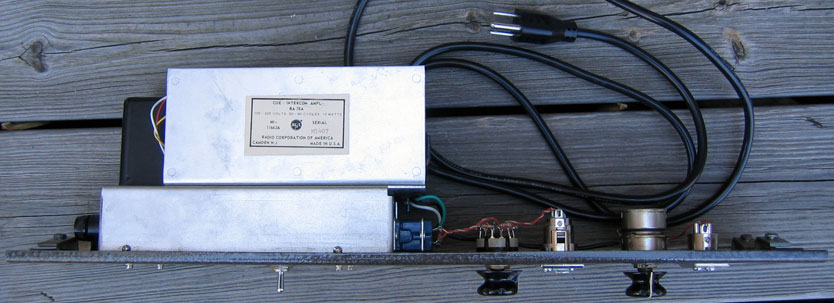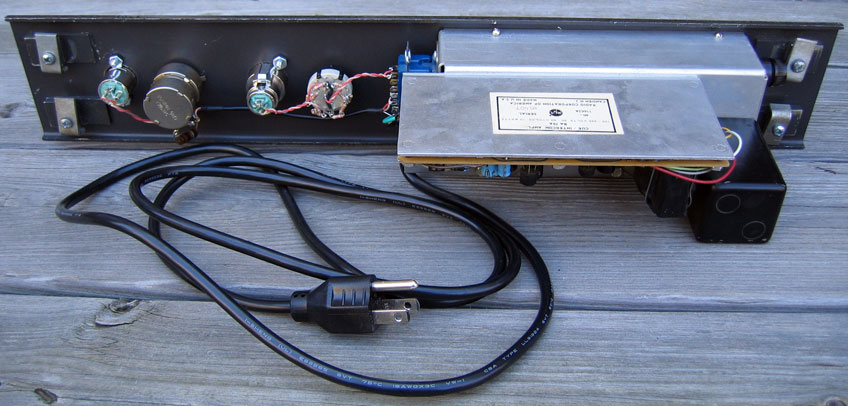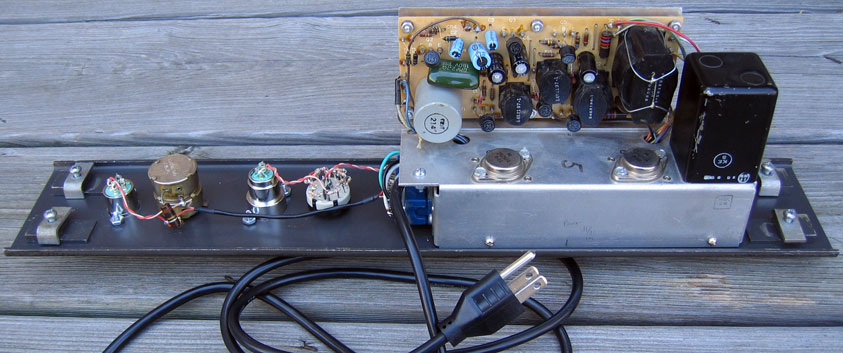Early 1960's RCA BA-78A Cue / Intercom amplifier. Set up with variable input pad and output attenuator on a General Electric rack panel. Dig that 'screwless' GE front face.
The BA-78 'A' version is a real era-bridging oddity that you usually only see as a sample circuit in an old transistor manual. Fully push-pull, with a transformer between every stage; 5 transformers! 90ish dB gain, several watts max output. Found in BC-7 / BC-8 type solid state consoles, meant for talkback purposes using relay switched 8 ohm speakers, limiter circuit built in which works at a very low threshold. Limiting achieved by variable shorting of a tertiary winding on the input transformer, which in turn varies the impedance reflected to the mic/speaker, and causes level losses. How's that for weird? There is a BA-78B version which is much more common. It uses the same method and has the same gain max, but a higher max output and it ditches the PP circuit in favor of a more traditional type with only input and output transformers.
The variable input pad is a very large string of series resistance maxing out in the 100K range, for line level inputs. The output is either 8 or 50 ohms, and this has a 50 ohm Mallory ladder which is almost always nearly all the way down. The limiting has an 'ideal' threshold, and RCA provided a chart for establishing ideal input pads. In the consoles, the output attenuator was on the faceplate.
What do you use it for? I put a mic behind a drum kit, turn the input pad to the lowest attenuation setting, and let it smash up a room sound. It mashes up a flat-lined wave form, and if you look at RTA, if also mashes all frequencies up to the same level. Somewhat upper mid-heavy, it is better with dark mics. I've used it as a talkback mic too; gee who would have thought. Harder to use with line level stuff; definitely a one trick pony with surprisingly clear sound, given what it's doing.




The BA-78 'A' version is a real era-bridging oddity that you usually only see as a sample circuit in an old transistor manual. Fully push-pull, with a transformer between every stage; 5 transformers! 90ish dB gain, several watts max output. Found in BC-7 / BC-8 type solid state consoles, meant for talkback purposes using relay switched 8 ohm speakers, limiter circuit built in which works at a very low threshold. Limiting achieved by variable shorting of a tertiary winding on the input transformer, which in turn varies the impedance reflected to the mic/speaker, and causes level losses. How's that for weird? There is a BA-78B version which is much more common. It uses the same method and has the same gain max, but a higher max output and it ditches the PP circuit in favor of a more traditional type with only input and output transformers.
The variable input pad is a very large string of series resistance maxing out in the 100K range, for line level inputs. The output is either 8 or 50 ohms, and this has a 50 ohm Mallory ladder which is almost always nearly all the way down. The limiting has an 'ideal' threshold, and RCA provided a chart for establishing ideal input pads. In the consoles, the output attenuator was on the faceplate.
What do you use it for? I put a mic behind a drum kit, turn the input pad to the lowest attenuation setting, and let it smash up a room sound. It mashes up a flat-lined wave form, and if you look at RTA, if also mashes all frequencies up to the same level. Somewhat upper mid-heavy, it is better with dark mics. I've used it as a talkback mic too; gee who would have thought. Harder to use with line level stuff; definitely a one trick pony with surprisingly clear sound, given what it's doing.






